When you compare the size and weight of a dozen textbooks to the size and weight of an e-reader with the same textbooks loaded onto it, there's no denying that the e-reader wins. But when you add in cost and usability, the portable e-reader may not be the best choice after all. Here's a rundown on the pros and cons of swapping textbooks for digital versions.
1. Ease of use
In 2011, Alex Thayer of the University of Washington conducted a study on e-reader use for academic purposes. Each student was given a Kindle DX loaded with books in the fall; by spring, just under 40 percent of them had stopped using the reader. Why? Usability issues.
Though the Kindle does allow you to annotate some books as you read, 75 percent of students in the study still used paper to take notes. The students also found it difficult to locate information in the text while taking tests or writing papers. Part of the problem, says Thayer, is that e-readers don't allow for "cognitive mapping," the process of using cues to remember where you saw the information in the first place. Navigation and search functions are also notoriously poor on most e-readers.
Thayer concluded that e-readers aren't built for academic reading, but many of the issues students encountered could be solved by switching to a tablet, such as an iPad. Since tablets more closely replicate the experience of using a computer, you can search, take notes, and even pick up page cues while reading a textbook.
2. Textbook availability
It doesn't matter if you're studying art history, nursing, or political science — there's an e-textbook out there to suit your needs. Amazon has a huge selection of books available for download to a Kindle or Kindle app on a computer, tablet or smartphone. You can buy the text outright or, in some cases, rent the book for the semester.
Apple also sells textbooks for iPad via iBooks 2. Books for high school students begin at $14.99, but don't forget that an iPad 2 costs at least $399 and the new iPad starts at $499.
Chegg rents e-textbooks as well, but unlike Amazon's books, they're not downloadable. Because it only rents, Chegg streams the books, so you have to have an active internet connection in order to access a text. This means you can't use an e-reader, but you can use a tablet or a desktop or laptop computer.
The best thing about downloading a textbook is that you don't have to stand in line at the university bookstore or wait for a package to arrive in the mail. When you purchase an e-textbook, the file is accessible within minutes, so it’s perfect for those who leave class prep to the last minute.
If you’re an English Lit major, bookmark Project Gutenberg. This online digital library has links to all of the classics, completely free of charge.
3. Portability
Portability is the one area where the e-readers and tablets really shine. Studies show that carrying a heavy backpack can cause serious damage to the spine, but textbooks still continue to rise in size.
Then there's the issue of bulk. You can easily load a whole semester's worth of textbooks onto an e-reader — but try doing that with a backpack.
E-readers like the Kindle can hold up to 3,500 books yet weigh less than a single paperback book. Tablets weigh approximately one and a half pounds, but "Calculus: Early Transcendentals" weighs more than five. Unless you're taking weight training as your P.E. requirement, you're better off lightening the load.
4. Cost
A typical college textbook costs anywhere between $40 to $200. Multiply that by the number of classes in a semester, and books can be a real budget buster. You'd think that an e-book version of a hefty text would be a big cost saver, but it's not always true. "Fundamentals of Forensic Science" by Max M. Houck and Jay A. Siegel sells for roughly $83.95. The Kindle price is $70.53 to buy or $32.74 to rent for four months. The e-book still sounds like a good deal — except that you can sell the print version back to Amazon for $40.68 credit. You can also rent a print copy of this same book for 125 days from BookRenter for only $33.53.
If you have to factor in the cost of buying a new e-reader or tablet, it could take a year of schooling before it pays for itself.
E-reader or print?
Buying e-versions of textbooks will save you some money on the cost of your books, and you won't strain your back carrying them to class. But using an e-reader isn't always the best choice. If the text is going to be used as your main reference for a semester or more, you'll find the print version is easier to search and annotate. What you'll gain in ease of use might make it worth the extra money and weight.
The biggest con could be the process of reading electronically itself. As the University of Washington study seems to indicate, reading a print textbook may lead to better recall of the material when it's time to take the exam.
More from Tecca:
